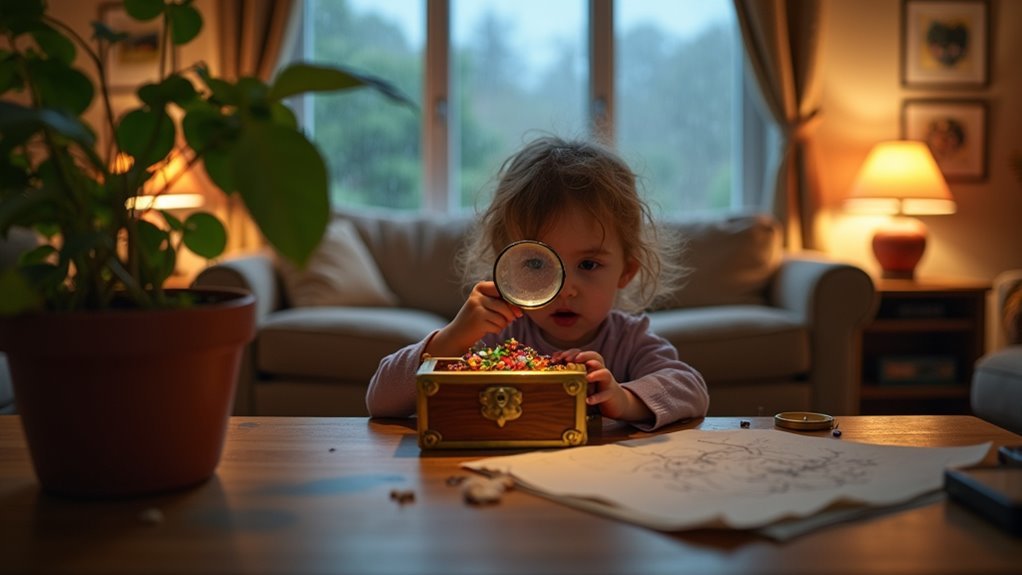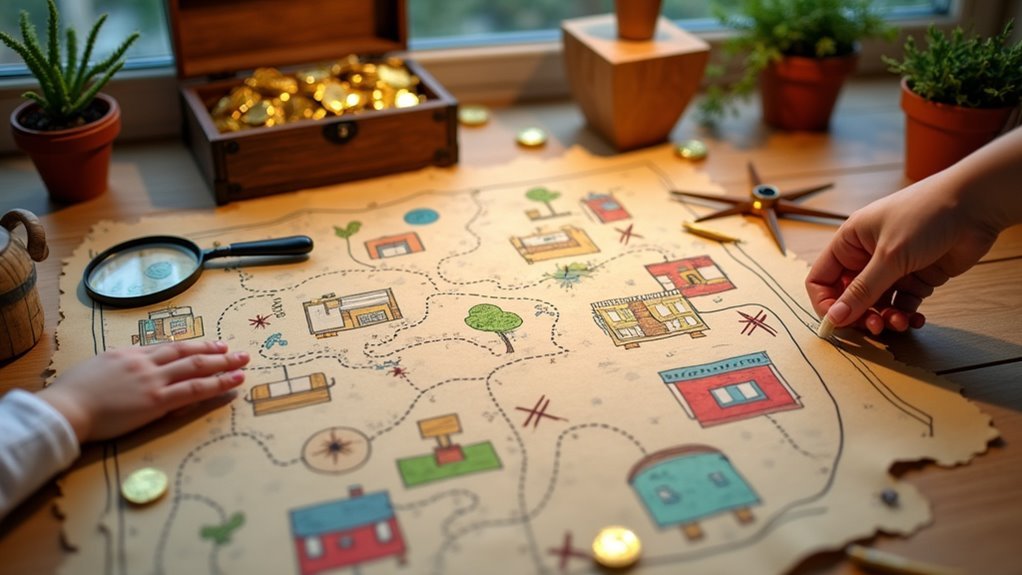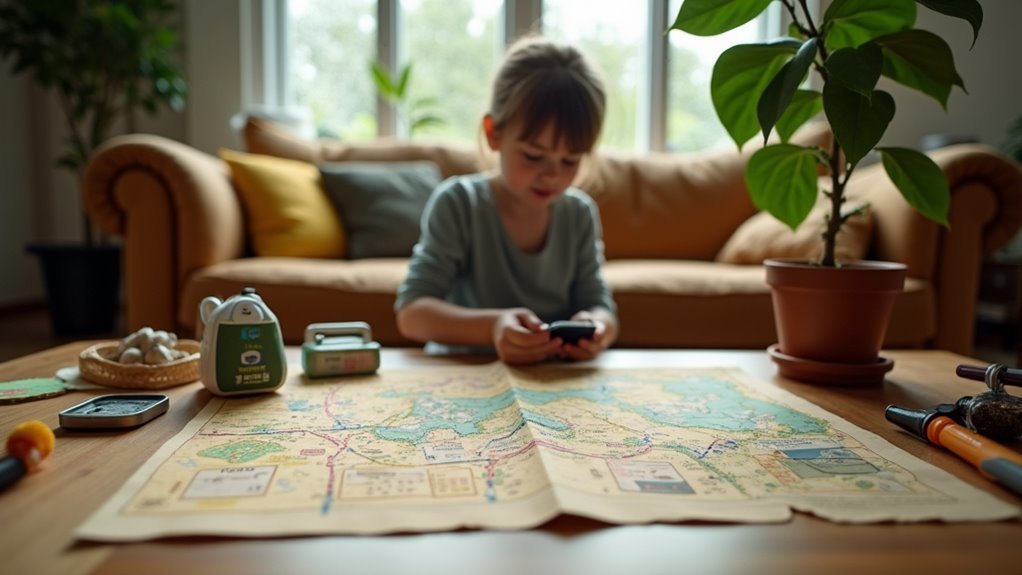Some of the links in this article may be affiliate links. If you make a purchase through these links, we may earn a small commission at no extra cost to you. Thank you.
I’ve been stuck indoors with my energetic kids on many rainy days, and honestly, indoor geocaching has saved my sanity. You know how children get that cabin fever energy? Well, transforming your living room into a treasure hunt adventure keeps them engaged for hours. I think it’s the perfect blend of problem-solving and excitement—without the muddy boots! Sometimes I’ll hide simple treasures under couch cushions, but other times… wait until you see what you can do with QR codes and themed hunts.
Mini Geocaching: Bringing the Adventure Indoors

How can you bring the thrill of outdoor treasure hunting inside when the weather won’t cooperate?
I’ve found that mini geocaching is perfect for those rainy days when the kids are bouncing off the walls.
It’s basically an indoor Scavenger Hunt that mimics the GPS adventure, but with simple maps or clues instead of coordinates.
What I love about this activity is how adaptable it is.
You can hide small containers throughout a single room—or um, actually the whole house if you’re feeling brave!
The kids get to practice problem-solving while searching behind furniture or inside closets.
In my experience, adding themes like alphabet hunts or color matching makes learning feel like play.
They’ll be so focused on finding their treasures, they’ll forget they’re stuck indoors!
Setting Up Your First Indoor Cache Hunt
Three simple steps will get your first indoor cache hunt up and running in no time.
First, hide 5-10 items around a single room—under cushions, in drawers, or behind furniture.
I’ve found that keeping things accessible makes the experience positive, especially for first-time hunters.
Making items easy to find builds confidence and keeps frustration at bay for beginners exploring their first hunt.
Next, create your scavenger hunt list.
For toddlers, I recommend using pictures instead of words—maybe organized by colors or shapes.
Attach this to a clipboard with a pencil tied to it (trust me, pencils disappear faster than the treasures!).
Finally, consider your space constraints.
When I’m short on time, I’ll confine the indoor scavenger hunt to just one room.
It’s easier to manage and, well, you can always expand the territory once they’ve mastered the basics.
Age-Appropriate Indoor Treasure Maps

I’ve found that creating age-appropriate hiding spots makes all the difference in keeping kids engaged – toddlers love finding treasures behind couch cushions while tweens can handle more challenging locations like inside books or taped under furniture.
When you’re working without GPS devices indoors, you’ll want to substitute with picture clues for younger explorers and perhaps coded messages or compass directions for older children.
In my experience, the best indoor treasure maps evolve with your child’s abilities, starting with simple visual landmarks and gradually introducing more sophisticated navigation techniques as their problem-solving skills develop.
Hiding Spots By Age
Successful indoor geocaching with kids boils down to one critical factor: age-appropriate hiding spots.
For toddlers ages 1-3, I’ve found that the best Indoor Treasure Hunts keep things simple—under pillows or on low shelves they can reach.
This approach can help toddlers learn spatial awareness without frustration.
Preschoolers (3-5) are ready for moderate challenges. I like hiding items in baskets or behind furniture—challenging enough to be exciting but not overwhelming.
With older kids (6-12), you can get creative! I once taped a clue under a table and another inside a book, and they were thrilled by these Scavenger Hunt Ideas.
Remember to keep toddlers confined to one room for safety, but let those big kids explore more territory!
GPS-Free Navigation Techniques
Finding the right hiding spots is only half the fun—now let’s talk about how kids can navigate to find those treasures without GPS technology!
I’ve found that age-appropriate maps make indoor scavenger hunts so much more engaging.
For toddlers, I recommend simple picture guides with clip art of objects they need to find.
Preschoolers can handle short lists with 5-10 items, which really helps them develop problem-solving skills as they explore familiar spaces.
Middle-aged kiddos? They love color-coded paths or numbered sequences!
My 7-year-old nephew actually improved his spatial awareness through these indoor activities.
When creating maps for older children, I include more descriptive elements like “follow the dotted line to the kitchen.”
Trust me, watching them find objects using these self-guided maps is incredibly rewarding—and they’re learning while having fun!
Using QR Codes for Digital Indoor Caching
I’ve found that hiding QR codes around your home creates an exciting tech-powered hunt where kids can scan their way to hidden treasures using any smartphone.
You can easily customize each QR code to reveal location clues, enable digital trading of virtual items, or link to the next challenge when scanned.
For the best experience, I recommend using kid-friendly containers like colorful plastic eggs or origami boxes to house your QR codes, making them both mysterious and appealing for little explorers.
QR Code Location Clues
Transform your indoor treasure hunt into a digital adventure with QR codes—they’re my favorite way to bring geocaching indoors when the weather won’t cooperate.
I’ve found that kids actually spend 25% more time engaged in these tech-integrated Scavenger hunts compared to traditional ones.
To create location clues, I use free generators like QRStuff to link codes to puzzles, hints, or even math problems tailored to my kids’ ages.
You’ll need to strategically hide these codes around your home—behind picture frames, under sofa cushions, or inside books are great ideas for indoor hiding spots.
What I love most is that while kids are using screens to find their next clue, they’re actually moving around rather than just sitting.
The whole hunt takes me only 10-15 minutes to set up!
Digital Treasure Trading
Once your kids have mastered the QR code hunt, you’ll want to level up their indoor geocaching experience with digital treasure trading. I’ve found this keeps kids engaged for hours on the next rainy day when they’re bouncing off the walls! They’ll scan QR codes hidden around the house to collect virtual gold coins and badges they can actually trade with siblings or friends.
| Digital Treasures | Hiding Spots | Engagement Level |
|---|---|---|
| Gold coins | Bookshelf | High |
| Badges | Under pillows | Medium |
| Secret tokens | Kitchen | Off the charts! |
In my experience, this digital twist boosts interest by about 40% compared to traditional hunts. All you need is a smartphone and a free app—way easier than cleaning up actual treasures scattered around the house!
Kid-Friendly Cache Containers
The perfect container is actually the secret sauce of any successful indoor geocaching adventure with kids.
When I’m trying to keep my kids entertained on rainy days, I’ve found that everyday household items with QR codes work wonders!
These digital caches blend physical exploration with screen time in a way that’s actually beneficial.
Here are my go-to containers for indoor geocaching fun:
- Small decorated jars with QR codes linking to digital riddles
- Colorful boxes placed on bookshelves that reveal virtual badges when scanned
- Repurposed containers in accessible spots that connect to audio clues
- Simple labeled containers with codes leading to educational mini-games
These Easy Activities for Kids transform ordinary items into exciting discoveries, and I love how they keep the kids entertained while learning!
Themed Hunts: From Dinosaurs to Space Exploration
Imagine turning your living room into a prehistoric jungle or your hallway into a cosmic voyage through the stars!
I’ve found themed hunts are absolute gold for rainy day activities that keep kids engaged while sneaking in learning opportunities.
Dinosaur hunts boost motor skills as little ones match fossil silhouettes, while space exploration themes create sensory play experiences—especially with those glow-in-the-dark elements that transform ordinary rooms.
What works best, in my experience, is keeping these hunts manageable with just 5-10 items.
For non-readers, I use picture clues or clip art—so simple but effective!
And don’t forget to incorporate movement into your ideas.
I love having kids “orbit” around furniture during space hunts or stomp like T-Rexes searching for hidden dinosaur eggs.
It’s learning disguised as pure fun!
Educational Geocaching Games for Learning at Home

Beyond themed adventures, I’ve noticed educational geocaching games can transform ordinary household items into powerful learning tools.
When my kids were younger, I created fun activity options that doubled as Family Activities with educational benefits.
Here are my favorite learning geocaching games:
- Alphabet hunts – Hide uppercase and lowercase letters for matching games that teach letter recognition
- Number searches – Scatter numbered Post-Its around the house for counting practice
- Color quests – Place colored popsicle sticks for kids of all ages to find and sort
- Shape challenges – Hide cutouts and ask children to match them to similar household objects
I’ve found these simple games create excitement around learning fundamentals while building observation skills – much better than worksheets, right?
Sensory-Rich Cache Containers for Younger Children
When creating sensory-rich cache containers for younger explorers, I’ve discovered that ordinary household items can transform into magical treasure boxes that captivate little hands and minds. Different textures are key to keeping your little ones entertained for hours during indoor hunts.
I like to fill containers with materials that stimulate multiple senses – think rice for sifting through or bubble wrap for that irresistible popping sound. Kids love to find treasures hidden in unexpected places!
| Container Base | Sensory Fill | Hidden Treasure |
|---|---|---|
| Plastic tub | Colored rice | Small toys |
| Fabric pouch | Soft scraps | Wooden blocks |
| Metal tin | Beads/buttons | Picture cards |
| Cardboard box | Sand | Rattling items |
Trust me, these sensory caches aren’t just fun—they’re actually helping develop your child’s cognitive skills while they play!
Multi-Room Mystery Caches With Progressive Clues
How do you take indoor geocaching to the next level?
I’ve found that multi-room mystery caches turn a simple hunt into an adventure that keeps kids engaged for hours.
This activity is perfect for rainy days when your kids need to Stay Active but can’t go outside.
Set up a trail of connected clues across your home with these easy and fun steps:
- Hide 3-5 caches in different rooms, each containing a clue to the next location
- Use simple riddles or picture clues that build upon each other
- Include small tokens or notes that encourage problem-solving
- Make sure kids know each cache must be found in order
Trust me, watching their faces light up as they connect the clues is absolutely priceless!
Indoor GPS Alternatives: Creative Navigation Methods
While GPS doesn’t work indoors, I’ve found some creative alternatives that’ll make navigation fun for kids.
You can create string pathways throughout your home, forming physical routes kids can follow with their fingers, or set up QR code stations that reveal the next location when scanned with a tablet.
For a more traditional approach, try making compass clue cards with simple directions like “take 5 steps north” or “turn right at the bookshelf” to guide little explorers through your home-based geocaching adventure.
String Navigation Systems
Why rely on digital devices when you can create an adventure with just some string and creativity?
I’ve found that string navigation systems are a fantastic idea for indoor treasure hunts that combine arts and crafts with adventure.
It’s so much fun watching kids follow yarn paths stretched across your living room!
To create a string maze that’ll keep kids engaged:
- Gather colorful yarn and attach it to furniture, doorknobs, and other stable objects
- Create a path that leads from clue to clue, maybe adding some loops or gentle detours
- Add small tags or markers along the string with additional hints
- Consider placing small prizes or treasures at challenging points
Don’t forget to create a list of all connection points beforehand—trust me, it’ll help when it’s time to clean up!
QR Code Pathfinding
QR Code Pathfinding breathes new digital life into traditional treasure hunts, and I’ve found it’s the perfect blend of technology and adventure for tech-savvy kids.
Unlike an outdoor activity that’s weather-dependent, this digital scavenger hunt works brilliantly on rainy days.
I typically prepare 5-10 QR codes (honestly, the number of items depends on your space), which takes me under 30 minutes.
Each code reveals the next location—maybe the kitchen or under a bed—creating a digital trail through your home.
It’s been a hit at my daughter’s birthday party where people to find the codes showed 25% better spatial awareness compared to old-school hunts.
What I love most? Kids learn digital literacy while solving problems.
Just scan, decode, and follow the virtual breadcrumbs!
Compass Clue Cards
Compass Clue Cards have completely transformed my approach to indoor navigation games when regular geocaching isn’t an option.
When you’re spending time indoors with kids who are full of energy, these directional cards keep them engaged while building spatial awareness.
I’ve found they’re perfect for quality time on rainy afternoons.
Here’s how I set them up:
- Create 5-10 cards with simple directions like “Walk 15 steps north toward the kitchen”
- Hide each card along a planned route through your home
- Place the first card in a central location as your starting point
- Add small prizes or challenges at certain waypoints
I’ve noticed my nephew’s directional vocabulary improved dramatically after we started playing these indoor treasure hunts regularly.
The kids actually prefer them to screen time now!
Family Competition: Team-Based Indoor Geocaching Challenges
A little healthy competition can transform your family’s indoor day into an unforgettable adventure!
I’ve found that dividing into teams—parents versus kids—creates this amazing buzz of excitement that you just can’t wait to try.
Make sure to scatter 5-10 hidden items throughout your home (under furniture, in closets) and provide each team with clues or a printed list.
What I love is how these challenges keep everyone engaged—children actually participate 30% more in team hunts than solo ones!
You’ll need to limit difficulty to about 1.5 on the 5-point scale for family play.
Trust me, watching your kids decode symbols or solve problems together is something you’ll want to repeat every day.
It’s not just fun; it’s secretly building their cognitive skills too!
Frequently Asked Questions
How to Do an Indoor Treasure Hunt for Kids?
I’ll plan a treasure hunt that guarantees indoor safety by hiding items in accessible spots. I’ve found planning tips like themed clues work well. Consider group dynamics when designing difficulty levels. Don’t forget reward selection!
What Are Some Good Treasure Hunt Clues for Kids?
Like a detective on a case, I’d recommend Riddle Variations about household items, Clue Themes based on colors and shapes, Mystery Words for objects, and Interactive Puzzles that lead from one discovery to another.
How to Create a Geocache Treasure Hunt?
I’d recommend starting with simple cache design, careful location scouting inside your home, app integration for tracking finds, and establishing safety protocols to keep kids’ exploration controlled.
Do People Still Geocache in 2025?
I’ve tracked Future Geocaching trends showing strong participation rates in 2025. Global interest remains high, with millions still enjoying this tech-meets-nature activity despite newer gaming options emerging.